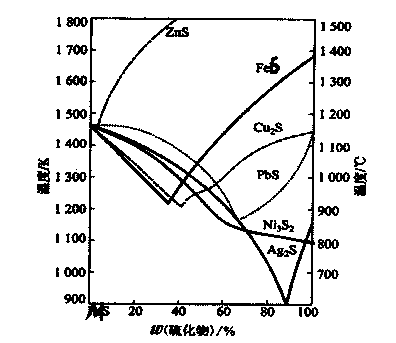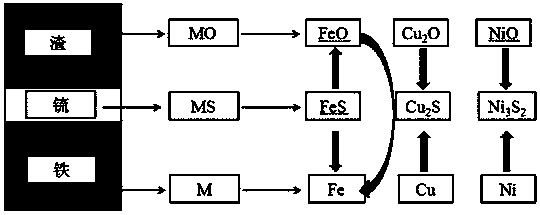Process for one-step reduction of metallurgical composite slag to obtain molten iron and matte phase
A composite slag and process technology, applied in the fields of iron and steel metallurgy and non-ferrous metallurgy, can solve problems such as separation difficulties, achieve broad application prospects, change the status quo of utilization, and achieve considerable economic and social benefits
- Summary
- Abstract
- Description
- Claims
- Application Information
AI Technical Summary
Problems solved by technology
Method used
Image
Examples
Embodiment 1
[0031] The water-quenched copper slag in Yunnan has a TFe content of 40.57%, a copper content of 0.75%, and a natural alkalinity of 0.15. Grind copper slag to a powder with a particle size of less than 0.125 mm, add a certain amount of lime and coal powder and mix to prepare carbon-containing pellets. The prepared carbon-containing pellets were dried in an oven at 200°C for 4 hours, and then put into a tubular resistance furnace at 1400°C and kept in a graphite crucible for 40mins for melting. Weigh the mass of granular iron obtained after melting to determine the yield of iron, and determine the copper content of the sample through chemical titration analysis. The analysis results show that when the alkalinity is 1.0, the yield of iron increases with the extension of the holding time, and the yield reaches 91% when it reaches 40mins, and the content of granular iron and copper decreases with the extension of the holding time, and decreases to 0.4% at 40mins , The removal rat...
Embodiment 2
[0033] Jiangyin copper slag has a TFe content of 42.94%, a copper content of 0.69%, and a natural alkalinity of 0.07. Grind Jiangxi copper slag to a powder with a particle size of less than 0.125 mm, add a certain amount of lime and coal powder and mix well to prepare carbon-containing pellets. The prepared carbon-containing pellets were dried in an oven at 200°C for 4 hours, and then put into a tubular resistance furnace at 1400°C and kept in a graphite crucible for 40mins for melting. Weigh the mass of granular iron obtained after melting to determine the yield of iron, and determine the copper content of the sample through chemical titration analysis. The analysis results show that when the alkalinity is 1.0, the yield of iron is 92.3%, the content of iron and copper in grains is reduced to 0.38%, and the removal rate of copper in iron exceeds 75%.
Embodiment 3
[0035] Jinchang high-nickel slag has a TFe content of 32.97%, a nickel content of 0.639%, and a natural alkalinity of 0.59. Grind copper slag to a powder with a particle size of less than 0.125 mm, add a certain amount of lime and coal powder and mix to prepare carbon-containing pellets. The prepared carbon-containing pellets were dried in an oven at 200°C for 4 hours, and then put into a tubular resistance furnace at 1400°C and kept in a graphite crucible for 40mins for melting. Weigh the mass of granular iron obtained after melting to determine the yield of iron, and determine the nickel content of the sample through chemical titration analysis. The analysis results show that when the alkalinity is 1.0, the yield of iron increases with the prolongation of the holding time, and the yield reaches 88% when it reaches 40mins. , The removal rate of nickel in iron is 85%.
PUM
 Login to View More
Login to View More Abstract
Description
Claims
Application Information
 Login to View More
Login to View More - R&D
- Intellectual Property
- Life Sciences
- Materials
- Tech Scout
- Unparalleled Data Quality
- Higher Quality Content
- 60% Fewer Hallucinations
Browse by: Latest US Patents, China's latest patents, Technical Efficacy Thesaurus, Application Domain, Technology Topic, Popular Technical Reports.
© 2025 PatSnap. All rights reserved.Legal|Privacy policy|Modern Slavery Act Transparency Statement|Sitemap|About US| Contact US: help@patsnap.com



